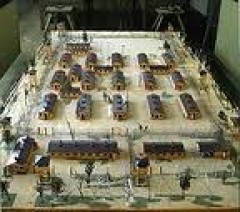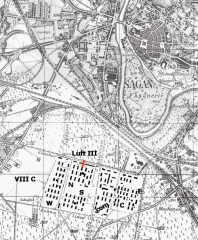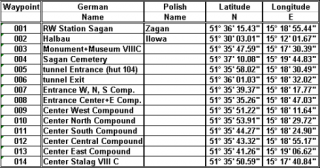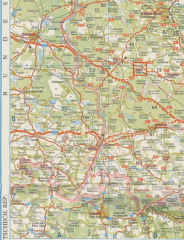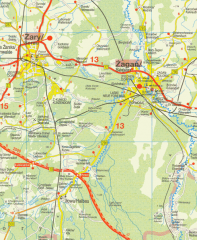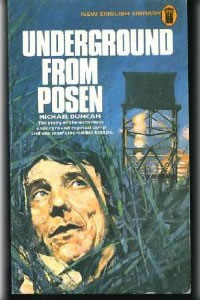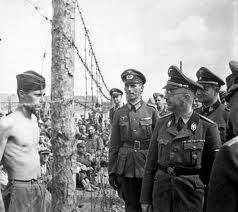Stalag Luft 3 was built next to an existing camp. In September and October 1939 the German Army built a POW camp for soldiers on a 48 ha area of land South of Sagan (Zagan), along the road to Halbau(Ilowa). This was Stalag VIII C. Initially, several thousand of Polish soldiers who had taken part in the September battles, were detained there. In 1940 these soldiers were deprived of their POW status, moved into Germany and forced to hard labor there. Soon the camp was filled with French prisoners whose number exceeded 45 000 in 1941.
In 1941, at the direction of Hermann Goering, an even bigger camp for Allied Officer airmen was built adjacent to Stalag VIII C in Eastern direction. This was Stalag Luft 3. The camp had six compounds, one of which was for German military personel (“com” on the next map). The East Compound (British) was first occupied March 21, 1942. The Center Compound on April 11, 1942. First with British sergeants and later in 1942 with Americans. The North Compound (British) was opened on March 29, 1943. The South Compound (Americans) in September 1943 and finally the West Compound (Americans) in July 1944.
We have projected the plan of Stalag Luft 3 onto a 1:25.000 topographic map from 1940. The squares on the map are 1 x 1 km. Stalag Luft 3 was adjacent to Stalag VIII C. The bright red line indicates where tunnel “Harry” was built.
Map extracts from Messtischblatt 4357 (1940) and 4457 (1936).
© Bundesamt für Kartographie und Geodäsie 2006.
Although hundreds of attempts to escape from the camp have been undertaken, Stalag Luft 3 has become world famous because of the “Great Escape” in the night from March 24-25, 1944. It involved the construction of a 336 ft (102 m) long tunnel (“Harry”)- the longest ever built in Germany during World War Two. Seventy-six officers escaped. All but tree were re-captured and of these, upon the order of Hitler, fifty were turned over to the Gestapo and were executed by shooting.
In due course the ashes of all those who had died were returned to the camp at Sagan, each urn bore the name of the victim and his date of execution. A Memorial of stone was built in the cemetery at Sagan by their brother officers in which their urns were entombed, but after the war were taken to the Old Garrison Cemetery at Poznan.
If you can look through the Hollywood style, the 1963 film “The Great Escape” with Steve McQueen, Charles Bronson, Richard Attenborough, Gordon Jackson and others, showed in great detail the preparations, the organization and the construction of the tunnel. The POW camp used in the film was named “Stalag Luft Nord” and was built amongst pine forests near Munich in Bavaria.
In the following table we have entered the latitudes and longitudes (WGS84) of some interesting places (not all on the map).
The next map shows that Sagan (Zagan) was situated in the SW corner of actual Poland, near the border with actual Germany and to the South not far from the border with actual Czech Republic.
Map extract from Polen, Planen & Touren, Übersichtskarte 1 : 1 000 000.
© Höfer Verlag 2006.
The next map shows in more detail the actual situation. We recognize the roads and railroads from before WW II. Stalag Luft 3 was situated South of Zagan, where on the map is marked the word “[Formosa]”. We do not know the meaning of this word.
Map extract from Polen, OstBrandenburg-NiederSchlesien PL002 1 : 200 000.
© Höfer Verlag 2006.
Google Earth
Unfortunately we are not allowed to reproduce how this area looks like in Google Earth. Despite the low resolution image, we can recommend you to launch the program anyway, as most points on the above maps can clearly be distinguished in Google Earth.
Important Remark
Long time after we finished this page we found out that it is much easier to enter the co-ordinates of a point in the “Fly to” box in Google Earth. Enter “51 35 58 N, 15 18 31 E” (without the quotes) for Stalag Luft 3 and zoom out far enough to see the whole picture.
Original text
Start Google Earth. In the upper left box “Fly to” type “Zagan Poland” (without the quotes). Google Earth zooms in to an Eye Alt of about 3600 ft, which does not make sense with this low resolution image. With the wheel on your mouse choose an “Eye Alt” (lower right corner of the screen) of about 28 000 ft. Drag the image a little up till the South of Zagan is in the center of your screen. Now you will immediately recognize the grounds of Stalag Luft 3. If you look more to the South, you will see an enormous military exercising terrain. On the right sight you can clearly see how tanks have ploughed the land (white traces).
Evacuation of Stalag Luft 3
The following Evacuation report is from the 303rd Bomb Group (H) Association website.
Russian troops were approaching Sagan, Poland. At 11:00 PM on 27 January 1945 Germans marched the POWs out of Stalag Luft 3 with Spremberg for their destination. The exodus was harrowing to POWs of all compounds, especially to those of the South Compound who made the 55 kilometers from Sagan to Muskau in 27 hours with only 4 hours sleep. At Muskau they were given a 30 hour delay for recuperation and then marched another 25 km to Spremberg. On 31 January the South Compound men plus 200 men from the West Compound went to Stalag 7A at Moosburg in rail “forty-and eight” boxcars packed 50 men and 1 guard in each boxcar. The trip took two days and two nights. On 7 February the men from the Center Compound joined them. The North Compound fell in with the West Compound at Spremberg and on 2 February entrained for Stalag 13D at Nurnberg, which they reached after a two day trip.
On April 13, 1945, after an approximate three month stay, the Americans were told that they must evacuate Stalag 13D and march to Stalag 7A at Moosburg. The main body reached Stalag 7A on 20 April 1945. Many POWs dropped out of the march en route to Moosburg and the German guards made no serious attempt to stop them. The POWs were liberated by General Patton’s 14th Armored Division on April 29th.
Museum and Monument
A Museum of Allied Prisoners of War Martyrdom was founded in 1971 on the grounds of Stalag VIII C. In front of the Museum is a Monument.
Memorial
In November 2000, a Great Escape Memorial Committee was formed with a mandate to establish a monument in Zagan to ensure the memory of the 50 who were executed. The committee commissioned the design of a monument to mark the entrance and exit of the tunnel. Working in conjunction with the local museum, it is expected that the monument will increase awareness of this historical event and also provide a location for family members to grieve and find closure. In November 2001, committee representatives traveled to Zagan and met with the Mayor, the Zagan Municipal Council and the Cultural Minister to discuss the project. The community was excited about the opportunity of preserving this historical event and educating future generations.
Map Source: Höfer Verlag 2006, Article Source GPS-practice-and-fun.com

